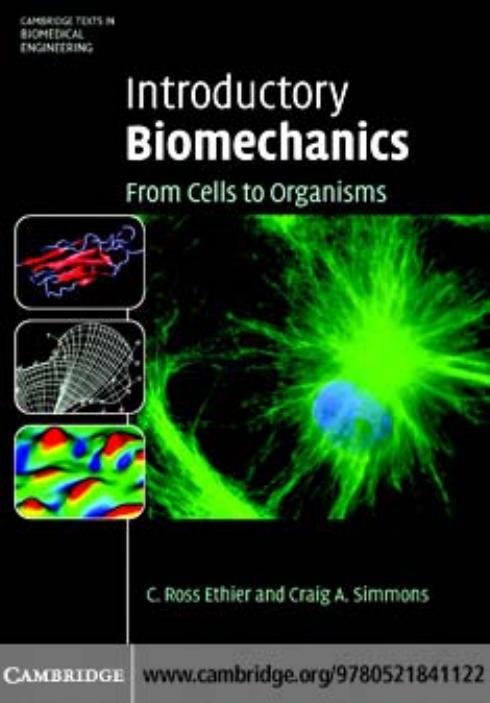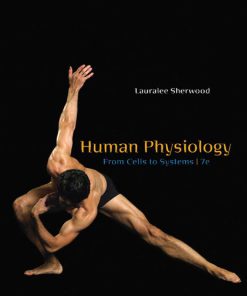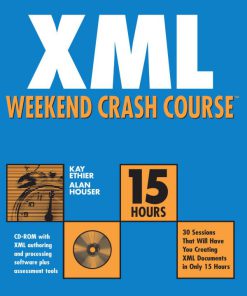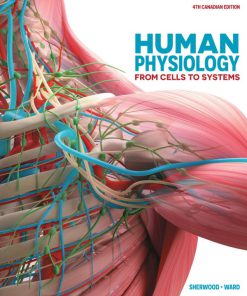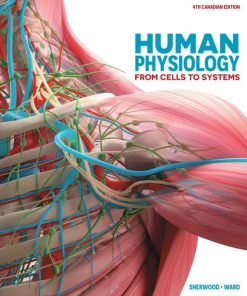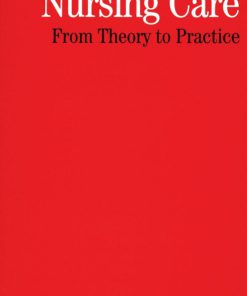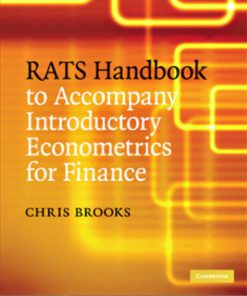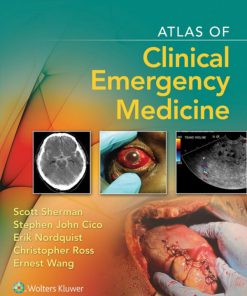Introductory Biomechanics From Cells to Organisms 1st Edition by Christopher Ross Ethier ISBN 0521841127 9780521841122
$50.00 Original price was: $50.00.$25.00Current price is: $25.00.
Authors:Christopher Ross Ethier , Series:Biomedical [19] , Tags:Biomedical , Author sort:Ethier, Christopher Ross , Ids:Google; 9781107086081 , Languages:Languages:eng , Published:Published:Apr 2007 , Publisher:CAMBRIDGE UNIVERSITY PRESS , Comments:Comments:”Introductory Biomechanics is a new, integrated text written specifically for engineering students. It provides a broad overview of this important branch of the rapidly growing field of bioengineering. A wide selection of topics is presented, ranging from the mechanics of single cells to the dynamics of human movement. No prior biological knowledge is assumed and in each chapter, the relevant anatomy and physiology are first described. The biological system is then analyzed from a mechanical viewpoint by reducing it to its essential elements, using the laws of mechanics and then tying mechanical insights back to biological function. This integrated approach provides students with a deeper understanding of both the mechanics and the biology than from qualitative study alone. The text is supported by a wealth of illustrations, tables and examples, a large selection of suitable problems and hundreds of current references, making it an essential textbook for any biomechanics course.”–Pub. desc.
Introductory Biomechanics From Cells to Organisms 1st Edition by Christopher Ross Ethier – Ebook PDF Instant Download/Delivery. 0521841127, 9780521841122
Full download Introductory Biomechanics From Cells to Organisms 1st Edition after payment
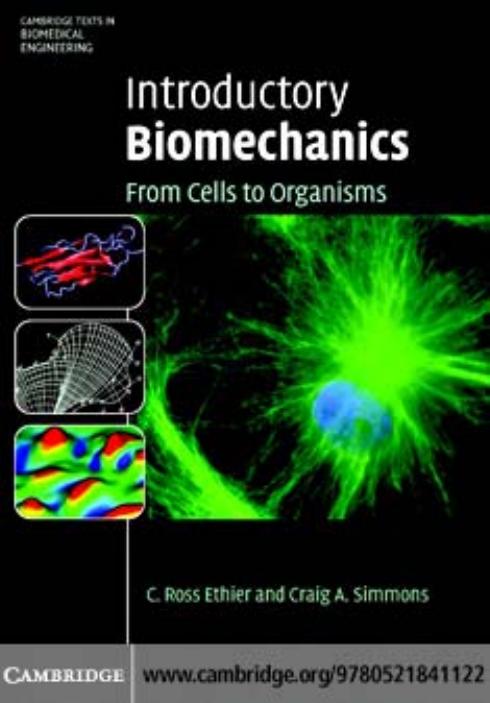
Product details:
ISBN 10: 0521841127
ISBN 13: 9780521841122
Author: Christopher Ross Ethier
Introductory Biomechanics is a new, integrated text written specifically for engineering students. It provides a broad overview of this important branch of the rapidly growing field of bioengineering. A wide selection of topics is presented, ranging from the mechanics of single cells to the dynamics of human movement. No prior biological knowledge is assumed and in each chapter, the relevant anatomy and physiology are first described. The biological system is then analyzed from a mechanical viewpoint by reducing it to its essential elements, using the laws of mechanics and then tying mechanical insights back to biological function. This integrated approach provides students with a deeper understanding of both the mechanics and the biology than from qualitative study alone. The text is supported by a wealth of illustrations, tables and examples, a large selection of suitable problems and hundreds of current references, making it an essential textbook for any biomechanics course.
Introductory Biomechanics From Cells to Organisms 1st Edition Table of contents:
1.1 A brief history of biomechanics
Figure 1.1
Figure 1.2
Figure 1.3
Figure 1.4
Figure 1.5
1.2 An outline of this book
Figure 1.6
Box 1.1 Systems biology and the integration of information
Figure 1.7
References
2 Cellular biomechanics
2.1 Introduction to eukaryotic cellular architecture
Figure 2.1
Figure 2.2
2.2 The cell’s energy system
Figure 2.3
2.3 Overview of the cytoskeleton
Figure 2.4
Figure 2.5
2.3.1 Actin filaments
Figure 2.6
Table 2.1. Summary of Young’s modulus values for F-actin measured by various methods. Modified with permission from Janmey et al. [13].
Figure 2.7
Figure 2.8
2.3.2 Intermediate filaments
2.3.3 Microtubules
Figure 2.9
Figure 2.10
2.4 Cell–matrix interactions
Figure 2.11
Figure 2.12
Figure 2.13
Figure 2.14
Figure 2.15
Table 2.2. Typical magnitudes of quantities measured on the cellular scale (last column)
2.5 Methods to measure the mechanical properties of cells and biomolecules
2.5.1 Atomic force microscopy
Figure 2.16
Figure 2.17
Figure 2.18
Figure 2.19
Figure 2.20
Figure 2.21
2.5.2 Optical trapping (“optical tweezers”)
Figure 2.22
2.5.3 Magnetic bead microrheometry
Figure 2.23
2.5.4 Micropipette aspiration
Figure 2.24
Figure 2.25
Figure 2.26
Figure 2.27
Figure 2.28
Figure 2.29
Figure 2.30
Figure 2.31
Extensions of the micropipette aspiration technique
Figure 2.32
Figure 2.33
2.6 Models of cellular biomechanical behavior
2.6.1 Lumped parameter viscoelastic model of the cell
Figure 2.34
Figure 2.35
Figure 2.36
Figure 2.37
2.6.2 Tensegrity model of the cytoskeleton
Figure 2.38
Special case: T = 0
Small strain case
Figure 2.39
Figure 2.40
Figure 2.41
Figure 2.42
2.6.3 Modeling actin filaments as a foam
Unit cell model of the cytoskeleton
Figure 2.43
Predictions of actin network modulus
2.6.4 Computational model of a chondrocyte in its matrix
Figure 2.44
Figure 2.45
Figure 2.46
Figure 2.47
2.7 Mechanotransduction: how do cells sense and respond to mechanical events?
2.7.1 Mechanoreceptors
Figure 2.48
Integrins
Stretch-activated ion channels
Cell-surface receptor proteins
2.7.2 Intracellular signal transduction
Figure 2.49
Cytoskeleton-mediated signal transduction
Biochemically mediated signal transduction
Figure 2.50
2.7.3 Cellular response to mechanical signals
Figure 2.51
2.8 Techniques for mechanical stimulation of cells
Figure 2.52
2.8.1 Compressive loading
Hydrostatic compression
Platen compression
2.8.2 Stretching
Figure 2.53
Figure 2.54
Figure 2.55
Uniaxial stretch
Biaxial stretch
2.8.3 Fluid flow
Viscometers
Box 2.1 Proof that the stress is equi-biaxial for the circular membranes in the devices shown in Fig. 2.55
Figure 2.56
Flow chambers
2.9 Summary of mechanobiological effects on cells in selected tissues
Figure 2.57
2.9.1 Endothelial cells in the vascular system
Figure 2.58
2.9.2 Smooth muscle cells in vascular tissue
2.9.3 Chondrocytes in articular cartilage
2.9.4 Osteoblasts and osteocytes in bone
Figure 2.59
2.10 Problems
Figure 2.60
Figure 2.61
Figure 2.62
Figure 2.63
Table 2.3. For Problem 2.9
Figure 2.64
Figure 2.65
Figure 2.66
Figure 2.67
Table 2.4. Critical buckling loads for 10 microtubules stabilized by microtubule-associated protein. Data approximated from graphical data presented in Kurachi et al. [118].
Figure 2.68
Table 2.5. Young’s moduli for a variety of cell types and measurement techniques. Data after Stamenovic and Coughlin [71].
References
3 Hemodynamics
3.1 Blood rheology
Figure 3.1
3.1.1 Blood composition
Figure 3.2
Table 3.1. Constituents of arterial plasma. From Vander et al. [1]. Reproduced with kind permission of the McGraw-Hill companies.
Table 3.2. Formed elements in blood: erythrocytes (red cells) are responsible for oxygen and carbon dioxide transport; leukocytes (white cells) are responsible in part for immune function; and platelets are responsible in part for blood coagulation. From Caro et al. [2]. Reproduced with kind permission of Oxford University Press.
3.1.2 Relationship between blood composition and rheology
Table 3.3. Geometric parameters of normal human red cells. Statistics are from pooled data on 1581 cells taken from 14 subjects; cells were suspended in 300 mOsm buffer. From Tsang [4] as shown in Fung [5] with kind permission of Professor Y. C. Fung.
Table 3.4. Composition of red cells: as a first approximation, the red cell is essentially hemoglobin and water enclosed in a membrane. From Caro et al. [2]. Reproduced with kind permission of Oxford University Press.
Figure 3.3
Figure 3.4
Table 3.5. Summary of red cell interaction effects on blood rheology
Figure 3.5
Figure 3.6
3.1.3 Constitutive equation for blood
Figure 3.7
3.2 Large artery hemodynamics
3.2.1 Physical characteristics of blood flow patterns in vivo
Figure 3.8
Table 3.6. Typical hemodynamic parameters for selected vessels in a 20 kg dog and a 70 kg human (surface area 1.8 m2). α is the Womersley parameter (Section 3.2.3); ReD is the Reynolds number (based on vessel diameter) given as mean with peak value in parentheses. Values collated from a variety of sources by Milnor [17]. Reproduced with kind permission of Lippincott Williams & Wilkins.
Table 3.7. Comparison of hemodynamic parameters in selected arteries in humans. Q, mean (cycle-averaged) flow rate in ml/s; D, cycle-averaged diameter in mm; U0, mean (cycle-averaged) velocity in cm/s; ReD, Reynolds number based on D, U0 and an assumed blood kinematic viscosity of 3.5 cStokes; τ, mean wall shear stress determined from τ = 8µU0/D = 32 µQ/π D2, in dyne/cm2 (this formula for shear stress ignores approximately 10% error from mean flow–pulsatile interactions). Reproduced from Ethier et al. [12] with permission from WIT Press, Southampton, UK.
3.2.2 Steady blood flow at low flow rates
Figure 3.9
Figure 3.10
Figure 3.11
Box 3.1 Using Equation (3.8) to derive Poiseuille’s law for a Newtonian fluid
Figure 3.12
3.2.3 Unsteady flow in large vessels
Figure 3.13
3.3 Blood flow in small vessels
Figure 3.14
3.3.1 Fahraeus–Lindqvist effect
Figure 3.15
Figure 3.16
Figure 3.17
3.3.2 “Inverse” Fahraeus–Lindqvist effect
Figure 3.18
3.4 Problems
Figure 3.19
Table 3.8. For Problems 3.7 and 3.9
Table 3.9. For Problem 3.14
Figure 3.20
Figure 3.21
Figure 3.22
Figure 3.23
Figure 3.24
Figure 3.25
Figure 3.26
References
4 The circulatory system
4.1 Anatomy of the vasculature
Figure 4.1
Figure 4.2
Table 4.1. Characteristics of the vascular system in a 20 kg dog; this table is useful for giving a sense of the organization of the vascular tree. Similar to the human, it is clear that the majority of the blood volume is contained within the veins, while the capillaries present the largest cross-sectional area. Some entries in the table are based on direct measurements (e.g., the diameters of the largest vessels); some are based on morphometric studies of small tissue samples and extrapolation to the entire body (e.g., the capillary numbers), subject to constraints such as blood volume and percentage of blood in a given vascular region. Class is simply a way of categorizing vessels; all vessels within a given class have diameters ranging from 50 to 150% of the mean value for that class. Compiled by Milnor [4]. Reproduced with permission.
Figure 4.3
Figure 4.4
Figure 4.5
4.2 The heart
Figure 4.6
4.2.1 Gross anatomy of the heart
Figure 4.7
4.2.2 Qualitative description of cardiac pumping
Figure 4.8
Figure 4.9
4.2.3 Cardiac pumping power and ventricular function
Figure 4.10
Figure 4.11
4.3 Arterial pulse propagation
4.3.1 Systolic and diastolic pressure
Figure 4.12
4.3.2 Windkessel model
Figure 4.13
Box 4.1 Solution of Equation (4.10)
4.3.3 Arterial wall structure and elasticity
Figure 4.14
Figure 4.15
Figure 4.16
4.3.4 Elastic waves
Table 4.2. Values of the “pressure–strain modulus”, Ep, and other arterial parameters in humans. From more complete listings in Milnor [4] and Nichols and O’ Rourke [8], except the values for aortic root.
Figure 4.17
Figure 4.18
Box 4.2 A more complete derivation of Equation (4.22)
Figure 4.19
Box 4.3 Derivation of the Korteweg–Moens wave speed
4.3.5 Pressure–flow relationships: purely oscillatory flow
Figure 4.20
Box 4.4 The electrical/fluid flow analogy
4.3.6 Pressure–flow relationships: mean flow effects
4.3.7 Pressure–flow relationships: deviations from ideality
Viscous losses
Variation of arterial properties
Figure 4.21
Effects of branching and taper
Figure 4.22
Figure 4.23
4.4 The capillaries
Figure 4.24
Figure 4.25
Figure 4.26
4.4.1 Capillary filtration: the experiments of Landis
Figure 4.27
4.4.2 Osmotic pressure
Figure 4.28
4.4.3 Quantitative analysis of capillary leakage
Figure 4.29
4.5 The veins
4.6 Scaling of hemodynamic variables
Figure 4.30
Figure 4.31
Table 4.3. Allometric scaling relationships for selected cardiovascular parameters. a and b are coefficients in the equation y = aMb, where M is body mass in kg; LV, left ventricle; RV, right ventricle; ECG, electrocardiogram.
4.7 Problems
Figure 4.32
Figure 4.33
Figure 4.34
Figure 4.35
Figure 4.36
Table 4.4. For Problem 4.12. Data from Tai et al. [51].
Figure 4.37
Figure 4.38
Table 4.5. For Problem 4.14
Figure 4.39
Figure 4.40
Figure 4.41
Figure 4.42
Figure 4.43
Table 4.6. For Problem 4.24. From Vander et al. [10]. Reproduced with kind permission of The McGraw-Hill Companies.
References
5 The interstitium
5.1 Interstitial fluid flow
5.1.1 Darcy’s law
Figure 5.1
5.1.2 Clearance of edema
Figure 5.2
Detailed parameter derivation
Figure 5.3
5.2 Problems
References
6 Ocular biomechanics
6.1 Ocular anatomy
Figure 6.1
6.2 Biomechanics of glaucoma
6.2.1 Tonometry
Figure 6.2
Figure 6.3
Figure 6.4
Figure 6.5
Figure 6.6
6.2.2 Drainage of aqueous humor in normal and glaucomatous eyes
Figure 6.7
Figure 6.8
Figure 6.9
Figure 6.10
6.2.3 Aqueous humor circulation in the anterior chamber
Figure 6.11
6.2.4 Optic nerve head biomechanics
Figure 6.12
Figure 6.13
Figure 6.14
6.3 Ocular blood flow
Figure 6.15
Figure 6.16
Figure 6.17
6.4 Problems
Figure 6.18
References
7 The respiratory system
7.1 Gross anatomy
7.1.1 The conducting airways and pulmonary vasculature
Figure 7.1
Figure 7.2
Figure 7.3
Figure 7.4
7.1.2 Associated structures
Figure 7.5
Figure 7.6
Figure 7.7
7.2 Biomechanics of breathing
7.3 Lung elasticity and surface tension effects
Figure 7.8
Figure 7.9
Figure 7.10
Box 7.1 Analogy of an air bubble in liquid
Figure 7.11
Figure 7.12
7.4 Mass transfer
Figure 7.13
Figure 7.14
Figure 7.15
7.4.1 Blood-side acinar mass transfer
Figure 7.16
Figure 7.17
Table 7.1. Normalized blood gas partial pressure, p̂, in the alveolar model as a function of dimensionless axial position, x/Lchar
Complexities associated with O2 and CO2 transport
Figure 7.18
Assumptions of the blood-side model, and more sophisticated models
Figure 7.19
7.4.2 Air-side acinar mass transfer
7.4.3 Whole lung mass transfer
Figure 7.20
Figure 7.21
Table 7.2. Air composition in inspired and expired tidal volumes. All volumes in the table are referenced to BTP. The assumed molar fractions are in column two, corresponding to dry ambient air (trace gases are not shown). The corresponding partial pressures and partial volumes (in a 500 ml inspired tidal volume) are shown in columns three and four. The partial volumes in the expired tidal volume are shown in column 5, calculated as described in the text.
Table 7.3. Comparison of calculated and measured tidal volume compositions. Calculated compositions are from column five of Table 7.2, measured values are from Cooney [15]. With kind permission of Taylor & Francis.
7.5 Particle transport in the lung
Figure 7.22
7.6 Problems
Figure 7.23
Figure 7.24
Figure 7.25
Figure 7.26
Figure 7.27
Figure 7.28
Figure 7.29
Figure 7.30
Figure 7.31
Figure 7.32
Table 7.4. For Problem 7.16
Table 7.5. For Problem 7.17
Table 7.6. For Problem 7.18
Table 7.7. For Problem 7.19
References
8 Muscles and movement
Figure 8.1
8.1 Skeletal muscle morphology and physiology
Figure 8.2
Figure 8.3
Figure 8.4
Figure 8.5
Figure 8.6
Figure 8.7
8.1.1 Isotonic versus isometric contraction
Figure 8.8
Figure 8.9
Figure 8.10
Figure 8.11
8.2 Muscle constitutive modeling
Figure 8.12
Figure 8.13
Figure 8.14
Figure 8.15
Figure 8.16
Figure 8.17
Figure 8.18
8.3 Whole muscle mechanics
8.3.1 Parallel versus pinnate muscle types
Figure 8.19
Figure 8.20
8.4 Muscle/bone interactions
8.4.1 Foreleg motion in two species
Figure 8.21
8.4.2 Flexion of the elbow
Figure 8.22
Figure 8.23
Table 8.1. Origin and insertion points and other characteristics of the four major muscles participating in elbow flexion. LH is the distance from the effective center of rotation for the elbow to the muscle origin location on the humerus; LF is the corresponding measurement for the insertion location on the forearm. PCSA is the physiologic cross-sectional area of the muscle (see text). θ = tan− 1(LH / LF) is the angle that the muscle makes with respect to the horizontal when the forearm is in the position shown in Fig. 8.22. “Inserts into” refers to which bone the muscle inserts into in the forearm.
Figure 8.24
Figure 8.25
8.4.3 Biomechanics of the knee
Figure 8.26
Figure 8.27
Table 8.2. Measured femoro-patellar contact loads during squatting, for physiological joint angles. Values in the last column are femoro-patellar contact forces, and should be multiplied by three to get in vivo loads. Values are mean for n = 12 knees (±95% confidence intervals). Reprinted from Huberti and Hayes [35]. With kind permission of Elsevier.
Figure 8.28
Table 8.3. Calculated femoro-patellar contact loads during walking, based on the model shown in Fig. 8.28. Values in the last column are femoro-patellar contact forces, and should be multiplied by three to get in vivo loads. Values are mean for n = 12 knees (±95% confidence intervals). See Fig. 8.28 for explanation of symbols. From Maquet [33]. With kind permission of Springer Science and Business Media.
8.5 Problems
Figure 8.29
Figure 8.30
Figure 8.31
Figure 8.32
Figure 8.33
Figure 8.34
Figure 8.35
Figure 8.36
References
9 Skeletal biomechanics
9.1 Introduction to bone
Figure 9.1
Table 9.1. Distribution of bones in the arms and legs: flexibility is conferred by having more bones (and hence more degrees of freedom) as one moves distally; an exception is the spine, which has 33 vertebrae
Table 9.2. Approximate composition of the extracellular matrix of bone tissue based on consensus values from several sources
9.2 Composition and structure of bone
Figure 9.2
9.2.1 Cortical bone
9.2.2 Trabecular bone
Figure 9.3
Figure 9.4
Figure 9.5
9.3 Biomechanical properties of cortical and trabecular bone
Table 9.3. Summary of mechanical properties of human cortical bone based on data from Reilly and Burstein, Journal of Biomechanics, 8(1975), 393–405.
9.3.1 Cortical bone mechanics
Table 9.4. Summary of mean compressive properties of human trabecular bone from different anatomic locations. Values in parentheses are standard deviations. Femur specimens were pooled from both the proximal and distal femur. The specimens from the tibia, distal femur, and spine were tested in the longitudinal (inferior-superior) direction. The proximal femur specimens were oriented along the neck of the femur. Adapted from Keaveny [11]. Copyright 2001 from Bone Mechanics Handbook by Cowin. Reproduced by permission of Routledge/Taylor & Francis Group, LLC.
9.3.2 Trabecular bone mechanics
Figure 9.6
9.3.3 Trabecular bone mechanics: density dependence
Figure 9.7
Figure 9.8
9.3.4 Trabecular bone mechanics: unit cell models
9.4 Bone fracture and failure mechanics
Figure 9.9
9.4.1 Fast fracture
Figure 9.10
Figure 9.11
Figure 9.12
Figure 9.13
Figure 9.14
Figure 9.15
Table 9.5. Fracture toughness (Kc) and toughness (Gc) of cortical bone loaded in the longitudinal and transverse directions. These values are for mode I loading, as shown in Fig. 9.10. The fracture toughness values for human cortical bone are comparable to those of a tough ceramic, but an order of magnitude less those for aluminium and steel. Adapted from Martin et al. [20] with kind permission of Springer Verlag.
9.4.2 Fatigue fracture
Figure 9.16
Figure 9.17
Figure 9.18
Figure 9.19
9.5 Functional adaptation and mechanobiology
Figure 9.20
9.6 The design of bone
Table 9.6. Incidence of fracture of various bones in males aged 20–45 years. Bone nomenclature is given in Fig. 9.1. Adapted from Currey [26] with permission of the American Society for Bone and Mineral Research.
9.7 Introduction to soft connective tissues
Table 9.7. Biochemical constituents of soft connective tissues. The values for ligament refer to ligaments of the extremities; elastic ligaments (e.g., in the spine) have substantially more elastin (see the description of ligaments in Section 9.9.1). Minor non-collagenous proteins are not listed and make up the remainder of the dry weight.
9.8 Structure of collagen
Figure 9.21
Figure 9.22
9.9 Structure of ligament, tendon, and cartilage
9.9.1 Ligament
Figure 9.23
Figure 9.24
9.9.2 Tendon
Figure 9.25
9.9.3 Cartilage
Figure 9.26
9.10 Biomechanical properties of ligament, tendon, and cartilage
9.10.1 Structural properties
Figure 9.27
Figure 9.28
9.10.2 Material properties
Figure 9.29
Figure 9.30
9.10.3 Material properties: tension
Table 9.8. Equilibrium tensile moduli of skeletal connective tissues. Cartilage specimens were harvested from high-weight-bearing areas (HWA) or low-weight-bearing areas (LWA). The higher tensile moduli in the LWA correlated with a higher collagen to proteoglycan ratio in these regions.
9.10.4 Material properties: compression
Figure 9.31
Figure 9.32
9.10.5 Material properties: viscoelasticity
Figure 9.33
Figure 9.34
Figure 9.35
9.10.6 Material properties: biphasic mixture theory of cartilage
9.11 Problems
Figure 9.36
Figure 9.37
Figure 9.38
References
10 Terrestrial locomotion
10.1 Jumping
10.1.1 Standing jump
Figure 10.1
Figure 10.2
Figure 10.3
10.1.2 Running jumps
Pole vault
Running high jump
Figure 10.4
Figure 10.5
10.2 Description of walking and running
10.2.1 Walking
Figure 10.6
Figure 10.7
Figure 10.8
Figure 10.9
Figure 10.10
Figure 10.11
Figure 10.12
Figure 10.13
Figure 10.14
Step frequency
10.2.2 Running
Figure 10.15
Figure 10.16
10.3 Gait analysis
10.3.1 Kinematics
Figure 10.17
Figure 10.18
Table 10.1. Typical kinematic data gathered from gait analysis of normal subject. Marker locations are as shown in Fig. 10.18. and are measured in the sagittal plane from a fixed reference location following the convention in Fig. 10.17. The frequency of measurement was 50 Hz, with each frame corresponding to one measurement. Data courtesy of Dr. Jennifer A. Moore, University of Toronto.
Figure 10.19
Figure 10.20
10.3.2 Anthropometry
Figure 10.21
Table 10.2. Anthropometric data on segment mass, location of center of mass, radius of gyration and density. Segment masses are expressed relative to total body mass; locations of the centers of mass are expressed relative to the limb segment length (see Fig. 10.21 for definitions of limb segments); the radii of gyration are expressed relative to the segment length, about three points, namely the center of gravity (C of G) for the segment, the proximal end of the segment, and the distal end of the segment. Note that the radii of gyration are for rotation about the z axis (see Fig. 10.17). Collected from various sources in Winter [7]. Reprinted with permission of John Wiley & Sons, Inc.
Table 10.3. Correlations expressing the masses of different body segments in terms of overall body mass (M, in lbm). Compare with the first column of Table 10.2. From Miller and Nelson [1]. With kind permission of Lippincott Williams & Wilkins.
10.3.3 Kinetics
Figure 10.22
Link segment model
Figure 10.23
Figure 10.24
Table 10.4. Typical kinetic (force plate) data gathered from gait analysis of a normal subject. This data was gathered at the same time as that in Table 10.1, and frame numbers are identical for the two tables. Fx and Fy are the horizontal and vertical reaction forces on the foot, following the sign conventions in Fig. 10.17. xcop and ycop are the center of pressure of the reaction forces. The frequency of measurement was 50 Hz, and the mass of the subject was 65 kg. Data courtesy of Dr. Jennifer A. Moore, University of Toronto.
Table 10.5. Kinematic data derived from values in Table 10.1. See text for definition of symbols and derivation of the data.
Figure 10.25
Figure 10.26
Figure 10.27
Joint reaction forces versus bone-on-bone forces
10.4 Problems
Figure 10.28
Figure 10.29
Figure 10.30
Figure 10.31
Figure 10.32
Table 10.6. For Problem 10.14.
Figure 10.33
References
Back matter
Appendix The electrocardiogram
Table A.1. Ionic concentrations in frog muscle fibers and in plasma. The ionic composition of plasma is representative of extracellular fluid composition. Note the substantial differences in ionic composition across the muscle cell membrane, which is typical of the situation in all cells. From Aidley [1] with kind permission of the author.
Figure A.1
Figure A.2
Figure A.3
Table A.2. Standard (Einthoven) electrocardiogram electrode placement locations; the limbs act as conductors so that, for example, an electrode at the left wrist measures a potential at the left shoulder
Table A.3. Voltage differences taken to form standard (Einthoven) electrocardiogram leads (see also Fig. A.6 and Table A.2 for abbreviations).
Figure A.4
Figure A.5
Figure A.6
People also search for Introductory Biomechanics From Cells to Organisms 1st Edition:
introductory biomechanics from cells to organisms solutions
introductory biomechanics from cells to organisms pdf
introductory biomechanics from cells to organisms solution manual
intro to biomechanics quizlet
You may also like…
eBook PDF
XML weekend crash course 1st Edition by Kay Ethier, Alan Houser ISBN 0764547593 9780764547591
eBook PDF
Nursing Care From Theory to Practice 1st Edition by Christopher Bassett 1861564317 978-1861564313

